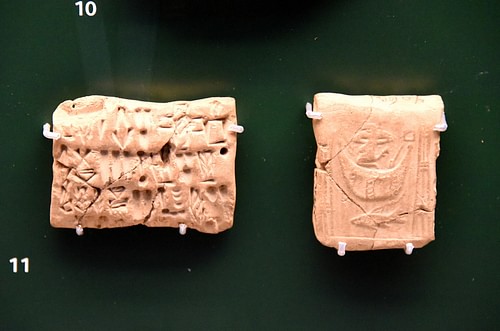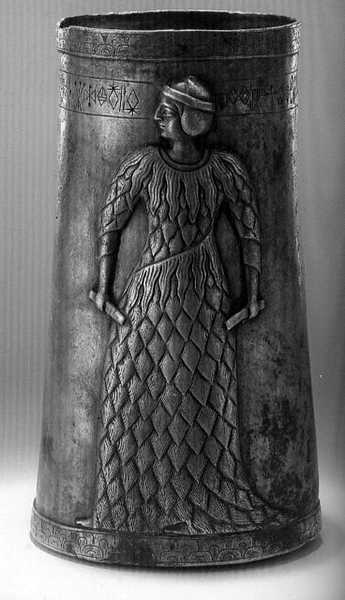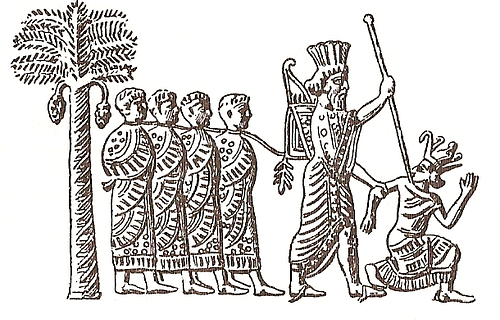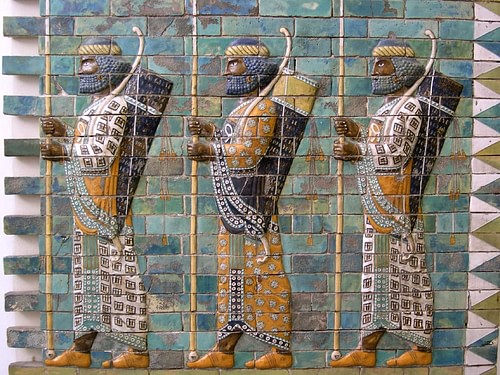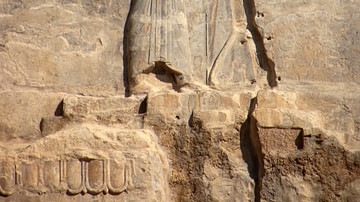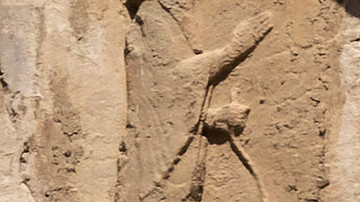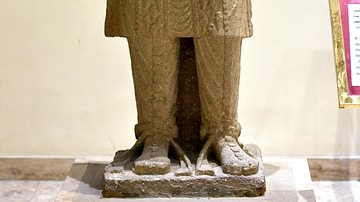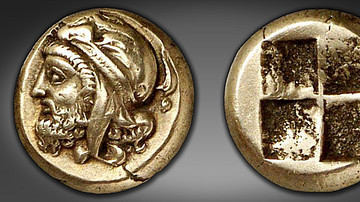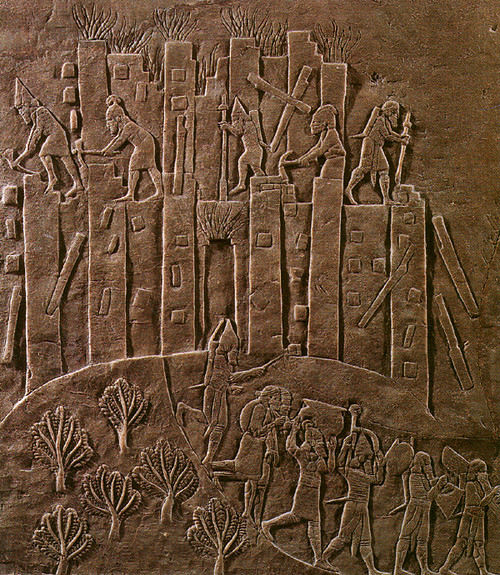
Susa was one of the oldest cities in the world and part of the site is still inhabited as Shush, Khuzestan Province, Iran. Excavations have uncovered evidence of continual habitation dating back to 4395 BCE but that early community grew from an even older one dating back to c. 7000 BCE.
Susa was a principal city of the Elamite, Achaemenid Persian, and Parthian empires and was originally known to the Elamites as 'Susan' or 'Susun'. The Greek name for the city was Sousa and the Hebrew, Shushan. It is mentioned in the Bible in the books of Daniel, Ezra, Nehemiah, and most notably the Book of Esther and was said to be the home of both Nehemiah and Daniel.
Although Shush presently occupies most of the ancient city's location, an archaeological site of largely unexcavated tells is nearby. The temple/palace area and graves were excavated in the 19th and 20th centuries CE but further excavation is required. According to UNESCO, “the excavated architectural monuments include administrative, residential, and palatial structures” and the site contains several layers of urban settlement dating from the 5th millennium BCE through the 13th century CE (1). The old city was situated between the modern rivers Karkheh and Dez (the rivers Choaspes and Eulaeus mentioned in the Biblical Book of Daniel 8:2, where Daniel received his vision), which bring mud down from the Zagros Mountains making the area one of the most fertile in the region.
It was the political center of Elam early in the 4th millennium BCE and there is a fortress, still extant, which dates back to this period as well as the ruins of buildings from the Persian, Macedonian, Syrian-Greek, and Parthian eras, making the Susa site of particular historical importance as it provides significant evidence of the evolution of cultures in the region over a vast period of time. It was accorded status as a site of Outstanding Universal Value by UNESCO in 2015 CE.
In c. 1764 BCE, Hammurabi of Babylon (r. 1792-1750 BCE) sacked the city and carried off the statues of the city's deities in retaliation for Elamite aggression. The Assyrian king Ashurbanipal (668-627 BCE) destroyed Susa completely between 645-640 BCE to avenge the perceived wrongs the people of Mesopotamia had suffered at the hands of the Elamites. The city was rebuilt and inhabited sometime after Ashurbanipal's attack only to be conquered by the Persian king Cyrus the Great (r.559-530 BCE) in 540 BCE. It was made the capital of the Persian Empire by Cambyses II (died 522 BCE) and was rebuilt and expanded upon by the Persian king Darius the Great (522-486 BCE) who favored it over his other residences.
There were other capitals in Persia (Pasargadae, Persepolis, and Ecbatana), but it is clear that Susa was the best known and most often mentioned. Persepolis, owing to its location, was unknown to the Greek historians until it was destroyed by Alexander the Great (r.336-323 BCE). After the defeat and destruction of the Achaemenid Empire by Alexander the Great, and then Alexander's death, Susa became part of the Seleucid Empire.
It was then known as Seleucia on the Eulaeus and Greek architecture and styling began to appear beside the older works of the Elamites and the Persians. The city remained an important intellectual, religious, and cultural center until it was sacked by Muslim armies in 638 CE and destroyed. Rebuilt yet again, it thrived until 1218 CE when it was utterly destroyed by invading Mongols.
Foundation & Early History
Susa began as a small village in the Neolithic Age c. 7000 BCE and had developed into an urban center by c. 4200 BCE. At some point in its development, the people created a monumental platform which served as the base for a temple, most likely dedicated to the god Inshushinak, patron deity of Susa. Inshushinak was the god of darkness and the afterlife and so it is no surprise that graves were dug around the platform and offerings made to both the god and the deceased. Over 2,000 such offerings, in the form of ceramic vessels, have been excavated from this area alone. According to the Metropolitan Museum of Art:
In addition to ceramics, the cemetery contained some fifty-five hammered copper “axes”. They are similar in shape to stone examples that have been widely found at contemporary sites and were probably used as hoes. These objects contain greater quantities of copper than do finds from any other site of the same period. Unquestionably they represent considerable wealth. (30)
Ceramics, agriculture, and metallurgy seem to have been the primary focus of employment in the city at this stage although images from the period show women at work in textiles. As Susa grew, the smaller villages surrounding it were abandoned and the so-called Proto-Elamite Period (c.3200-c.2700 BCE) moved on to the Old Elamite Period (c.2700-c.1600 BCE) during which ceramics became more refined and trade was established firmly with other nations. Scholar Susan Wise Bauer writes:
The Elamites had been living in their own small cities, over to the east of the Gulf, almost as long as Sumerians had occupied the Mesopotamian plain. Their ultimate origin, like that of most ancient people, is unknown, but their cities grew up not only just south of the Caspian Sea, but also along the southern border of the large sale desert plateau that lay east of the Zagros Mountains. From about 2700, the Elamites too had kings. Twinned cities, Susa and Awan, served as the center of their civilization. (88)
Awan was located north of Susa and was initially the more important of the two cities as a political and religious center. In 2700 BCE, King Enembaragesi of the Sumerian city of Kish defeated the Elamites of Awan and Susa in battle (the first recorded war in the history of the world) and briefly established Sumerian culture in the region. Sargon of Akkad (r.2334-2279 BCE) then absorbed the region into his Akkadian Empire but the kings of Awan were able to later negotiate their autonomy with Sargon's grandson Naram-Sin (r.2261-2224 BCE) at a time when Akkadian power was waning.
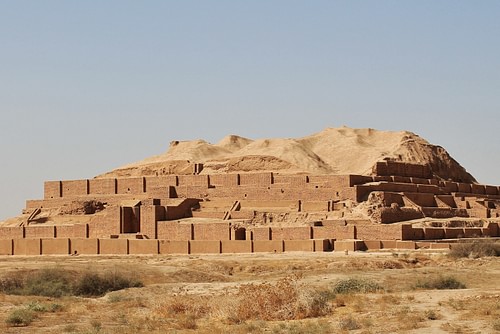
Susa would not retain its independence for long, however, and was taken by Shulgi of Ur (2029-1982 BCE) as part of his expansionist policy. Shulgi again introduced Sumerian culture to the city as cultural diffusion was a central platform of his administration. The Elamites and nomadic Amorites of the region resisted the Sumerian efforts, however, and threatened Ur whenever they felt strong enough; they finally succeeded in throwing off Sumerian domination during the latter part of the reign of Ibbi-Sin (1963-1940 BCE) when the Third Dynasty of Ur fell to the Elamites.
Between the time of Shulgi and Ibbi-Sin, however, Ur consistently lost power and prestige and was taken by Hammurabi of Babylon when he conquered the whole of Mesopotamia. Susa was among the Elamite cities sacked by the Babylonian king in c. 1764 BCE in response to Elamite aggression. The city was burned and the statues of the goddesses and their priestesses carried back to Babylon. According to Susan Wise Bauer, “This was a polite and sacred version of carrying off your enemy's wives and ravishing them” (172).
As Babylonian power declined following Hammurabi's death in 1750 BCE, Awan and Susa became stronger. In c. 1500 BCE Awan-Susa became powerful enough to conquer the southern city of Anshan and the monarchs of the period would sign their names, “King of Anshan and Susa” in a show of unity and strength of the region. Scholars identify this event as the beginning of the Middle Elamite Period (c. 1600-c. 1100 BCE) when Susa, and Elam generally, was at its peak.
Middle Elamite Period
At this time Susa became capital of the region of Susiana (corresponding to the Province of Khuzestan, Iran in the modern day) and Elamite script replaced Akkadian in official documents. The kings of Susa grew more and more powerful until, by c. 1200 BCE, they were in complete control of their region and began their own policy of expansion and conquest as well as grand building projects.
The most famous of these projects was the city of Dur-Untash and its temple complex, built by the Elamite king Untash-Napirisha (r. c. 1275-1240 BCE). Untash-Napirisha, for reasons which are unclear, located his great religious complex nineteen miles (31 km) south-east of Susa and surrounded it with a new city. Scholar Marc van de Mieroop describes the most impressive aspect of the project:
Its center was a massive ziggurat surrounded by an inner enclosure with numerous temples. Inside a second enclosure, more secular buildings were located. The ziggurat was devoted to Napirisha, the great god of Elam, and Inshushinak, the patron deity of Susa. The construction was truly monumental: it contained millions of bricks, a substantial part of which was baked at great expense of fuel. The inner core of sun-dried brick was encased in a 2-meter-thick layer of baked brick. Every tenth layer of the outer casing had a row of bricks inscribed with a dedication from Untash-Napirisha to Inshushinak. Because of the solidity of its construction, this is the best-preserved ziggurat in the Near East. (186)
Most likely, Untash-Napirisha created Dur-Untash simply because Susa at this time had become so well-developed. Even so, after his death the aristocrats of Susa stopped construction at Dur-Untash and religious rites continued at Susa. The Metropolitan Museum of Art notes that copper discs have been found at Susa, “probably worn by priests during certain ceremonies” and buried with their owners (30). Like the copper “axes” mentioned above, these discs attest to the wealth of the city at this time.
During the Middle Elamite Period, Susa prospered and flourished not only as the capital but a center of commerce and a religious site. The best artisans of the region were employed in creating grand structures and monuments and, as scholar Wolfram von Soden notes, the best translation of the name of these artisans is “specialists” who had studied extensively under a master (104-105). The kings of this period added to the city's splendor but probably none so much as those of the Shutrukid Dynasty (c. 1210-1100 BCE).
The best known of these kings is Shutruk Nakhunte (c. 1185-c. 1150 BCE) who invaded Mesopotamia, defeated the Kassites, and established the Elamite Empire. He is most famous, however, for his sack of the cities of Sippar and Babylon in c. 1150 BCE and carried the statue of the god Marduk, as well as the stele of the Code of Hammurabi, back to Susa. The Elamite Empire would last throughout the Skutrukid Dynasty but steadily lost power and vanished into the obscurity of the early part of the Neo-Elamite Period (c. 1100-c. 540 BCE).
The Neo-Elamite Period & Foreign Invasion
Little is known of the early Neo-Elamite Period as many of the records have either been lost or remain unexcavated. Evidence points to early clashes with the Neo-Assyrian Empire (912-612 BCE) and alliances with other powers but details are scarce. Assyrian documents, however, record Susa's support of the Chaldean rebel Merodach-Baladan against the Assyrian king Sargon II (722-705 BCE) and repeated clashes with his son Sennacherib (705-681 BCE).
Sennacherib's son, Esharaddon (681-669 BCE) conquered Elam and took Susa but did not damage the city. Good relations were established between Susa and the Assyrians afterwards but deteriorated under the reign of Esharaddon's son Ashurbanipal (668-627 BCE) after the Elamites rebelled and attacked Assyrian cities. Ashurbanipal crushed the uprising and sacked Susa, destroying the city.
The Neo-Assyrian Empire fell to a coalition led by Babylonians and Medes in 612 BCE and Susa at this time fell under the control of the Medes until Elam was taken by the Achaemenid Empire of Cyrus the great in 540 BCE. The Persian invasion effectively ends Elamite history but Susa continued as an important urban center. During the period of the Achaemenid Empire, Susa again flourished as the Persian kings devoted as much time and effort to beautifying the city as the former Elamite kings had.
Cambyses II made the city capital of the Persian Empire and Darius the Great built his monumental palace there which was added on to by his successors Xerxes I (r.486-465 BCE) and Artaxerxes I (r. 465-424 BCE). The Biblical Book of Esther is set in Susa, where king Ahasverus (Xerxes) threatened the Jews with genocide and Esther saved them. After him, during the rule of Artaxerxes I, a huge fire destroyed much of the city from this period. King Artaxerxes II Mnemon (404-358 BCE) rebuilt the city and added an audience hall (apadana) at Susa which was said to be most impressive. Ancient writers on the city always mention the grandeur of the buildings constructed by Artaxerxes II.
The city continued to flourish until it was sacked by Alexander the Great in 330 BCE. Even so, Alexander did not destroy the city and it became the site of the so-called Susa Weddings of 324 BCE in which he married over 10,000 Macedonians and Persians in an effort to unite the two cultures.
After Alexander's death in 323 BCE, the region went to his general Seleucus (r. 321-315, 305-281 BCE) who founded the Seleucid Empire and renamed the city Seleucia on the Eulaeus. Susa remained an important center of commerce, as well as the capital, during this period and would continue to thrive under the later Parthian Empire (247 BCE – 224 CE) during which time it was one of the two capitals (the other being Ctesiphon). As Ctesiphon was repeatedly taken by Rome during the Parthian-Roman conflicts, kingship was transferred to Susa, out of reach of Rome as it was further to the east and more easily defensible.
The Parthian Empire was toppled by Ardashir I (also known as Ardashir the Unifier, r.224-241 CE) who founded the Sasanian Empire (224-651 CE) and during this time Susa declined in prestige. It became a focal point for the Christian community of the region who antagonized the Sasanians through their alignment with Rome. Susa eventually drew Christians from the surrounding areas until it was sacked by the Sasanian king Shapur II (r.309-379 CE) who dispersed the population.
The city revived, however, and was again prosperous when it was sacked and destroyed by Muslim armies in 638 CE. The Arab forces are said to have found a silver sarcophagus during the invasion which was believed to house the body of the prophet Daniel from the Bible. The tomb of Daniel can still be visited in modern-day Shush. Susa again revived and remained a significant commercial and religious center until it was destroyed by invading Mongols in 1218 CE.
Conclusion
After the Mongol invasion, Susa lay in ruin and its buildings were harvested by the local population for stone. Although some buildings were still inhabited by nomads periodically, the city was largely abandoned until the 19th century CE when European and American museums and cultural institutions sent teams to the regions of ancient Mesopotamia and Persia in an effort to corroborate biblical narratives through archaeological evidence.
The first efforts at Susa were undertaken in 1854 CE with the first serious and systematic excavation taking place in 1884 CE, led by the French archaeologist Jacques de Morgan. This team felt under constant threat by the local population and devoted significant time and resources to building a castle for protection and as a base of operations. Although they were excavating and working to preserve the site of ancient Susa, they also used material from the site to construct the building now known as Shush Castle or the Archaeologist's Castle, dated to c. 1885 CE.
Excavations at the site continued into the 20th century CE although turmoil in the region has repeatedly interrupted the work there. Today Susa is considered one of the most important archaeological sites in the world and potentially among the largest since, although it has been excavated and researched for over 150 years, a significant portion of the ancient site remains buried. Urban expansion of Shush, as well as hydraulic works implemented upstream on the two nearby rivers, has threatened the site but conservation and preservation efforts continue and the ruins of the once great city of Susa continue to draw visitors from around the world as an archaeological park.
